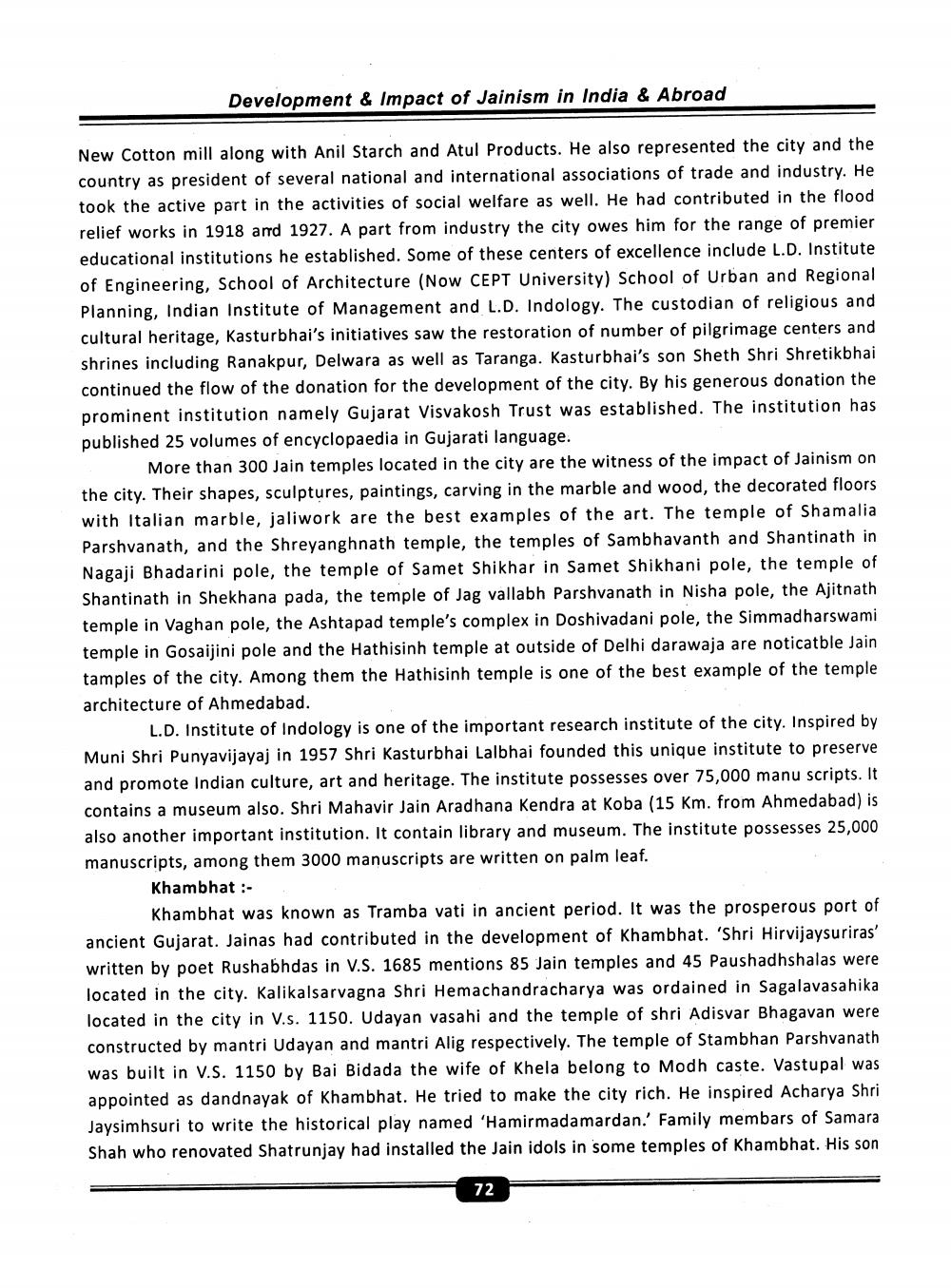________________
Development & Impact of Jainism in India & Abroad
New Cotton mill along with Anil Starch and Atul Products. He also represented the city and the country as president of several national and international associations of trade and industry. He took the active part in the activities of social welfare as well. He had contributed in the flood relief works in 1918 and 1927. A part from industry the city owes him for the range of premier educational institutions he established. Some of these centers of excellence include L.D. Institute of Engineering, School of Architecture (Now CEPT University) School of Urban and Regional Planning, Indian Institute of Management and L.D. Indology. The custodian of religious and cultural heritage, Kasturbhai's initiatives saw the restoration of number of pilgrimage centers and shrines including Ranakpur, Delwara as well as Taranga. Kasturbhai's son Sheth Shri Shretikbhai continued the flow of the donation for the development of the city. By his generous donation the prominent institution namely Gujarat Visvakosh Trust was established. The institution has published 25 volumes of encyclopaedia in Gujarati language.
More than 300 Jain temples located in the city are the witness of the impact of Jainism on the city. Their shapes, sculptures, paintings, carving in the marble and wood, the decorated floors with Italian marble, jaliwork are the best examples of the art. The temple of Shamalia Parshvanath, and the Shreyanghnath temple, the temples of Sambhavanth and Shantinath in Nagaji Bhadarini pole, the temple of Samet Shikhar in Samet Shikhani pole, the temple of Shantinath in Shekhana pada, the temple of Jag vallabh Parshvanath in Nisha pole, the Ajitnath temple in Vaghan pole, the Ashtapad temple's complex in Doshivadani pole, the Simmadharswami temple in Gosaijini pole and the Hathisinh temple at outside of Delhi darawaja are noticatble Jain tamples of the city. Among them the Hathisinh temple is one of the best example of the temple architecture of Ahmedabad.
L.D. Institute of Indology is one of the important research institute of the city. Inspired by Muni Shri Punyavijayaj in 1957 Shri Kasturbhai Lalbhai founded this unique institute to preserve and promote Indian culture, art and heritage. The institute possesses over 75,000 manu scripts. It contains a museum also. Shri Mahavir Jain Aradhana Kendra at Koba (15 km. from Ahmedabad) is also another important institution. It contain library and museum. The institute possesses 25,000 manuscripts, among them 3000 manuscripts are written on palm leaf.
Khambhat :
Khambhat was known as Tramba vati in ancient period. It was the prosperous port of ancient Gujarat. Jainas had contributed in the development of Khambhat. 'Shri Hirvijaysuriras' written by poet Rushabhdas in V.S. 1685 mentions 85 Jain temples and 45 Paushadhshalas were located in the city. Kalikalsarvagna Shri Hemachandracharya was ordained in Sagalavasahika located in the city in V.S. 1150. Udayan vasahi and the temple of shri Adisvar Bhagavan were constructed by mantri Udayan and mantri Alig respectively. The temple of Stambhan Parshvanath was built in V.S. 1150 by Bai Bidada the wife of Khela belong to Modh caste. Vastupal was appointed as dandnayak of Khambhat. He tried to make the city rich. He inspired Acharya Shri Jaysimhsuri to write the historical play named 'Hamirmadamardan. Family membars of Samara Shah who renovated Shatrunjay had installed the Jain idols in some temples of Khambhat. His son
72




